Kamsa HRIS Integrations Guide for HiBob
Overview
There are two methods of integrating with HiBob within Kamsa:
- Direct API connection (Recommended)
- Report-based connection (allows for customization)
Our recommended methodology is through the Direct API version.
If you have lots of customization in your account and feel like a customized report-based solution might be better for you, please see this documentation: Kamsa HRIS Integrations Guide — HiBob (Report-based Customization)
Regardless of which integration method is selected, please keep in mind that once such HRIS integration is added, it often exposes some inconsistencies with how data is entered into clients’ HRIS (there is often not a quick magic sync of data), so there will likely be modifications needed as well as testing required with our integration team before the data flows seamlessly into Kamsa.
Direct API Connection (Recommended)
Below are the steps to set up your HiBob integration in Kamsa:
- In HiBob, create an API Key (Service User ID & Token)
- Add the Service User ID + Token to Kamsa
- Create a Service User permissions group and assign it employee data permissions

- Email [email protected] to test and finalize your import
Step 1: Create a Bob Service User ID & Token, assign permissions
For detailed instructions, see Bob’s API Service Users documentation.
Create a Service User ID & Token
-
From the left menu, select Settings > Integrations
-
Select Automation
-
Click the Service Users thumbnail
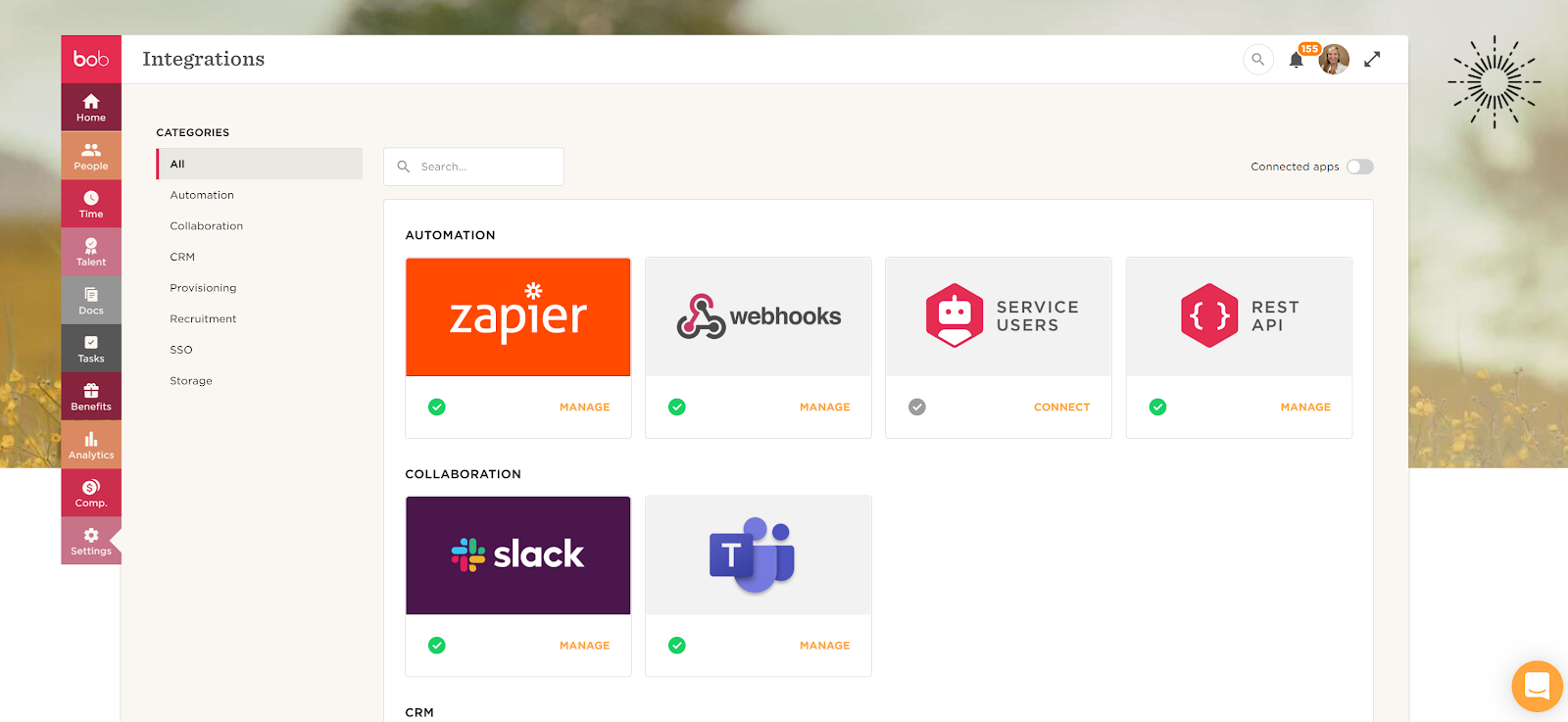
-
Enter a unique Name and a Display Name
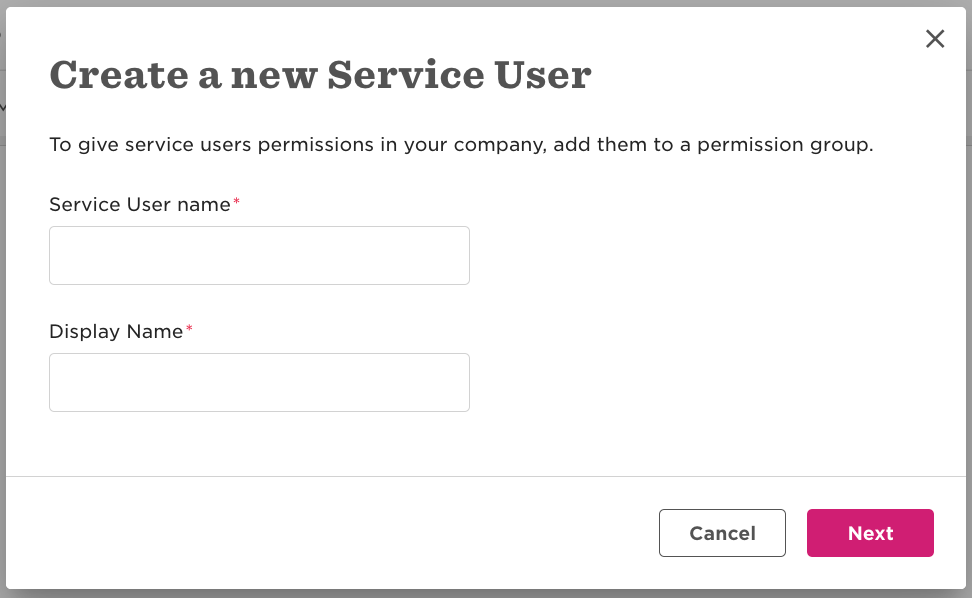
-
The new Service User ID and Token are now displayed.
Note: Once you hit Done on the next screen, you will not be able to access this screen and IDs again!

Make sure to keep the Token in a safe place (since you will not be able to view the token again once you bypass this screen). Click Next.
Assign Service User permissions
By default, Service Users are created with no access permissions. You’ll need to the following:
-
Create a dedicated permission group for the Service User
Go to Settings > Account > Permissions Groups > Create group and choose “Select people by condition.”

-
Add the Kamsa Service User to the group
Open up the “Select people” option and click into the Service User you’d like to assign. In the same window, delete the condition “Lifecycle status equals…”
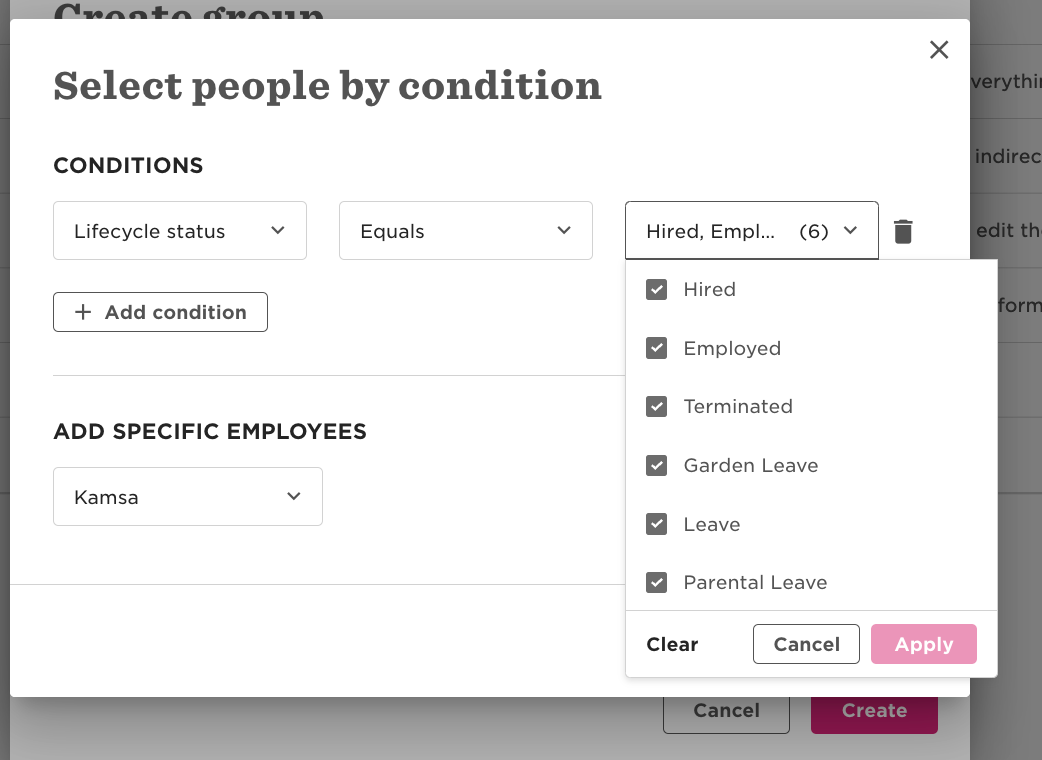
-
Set employee data permissions for the Service User.
Tab into the “view” for the following categories in Employee Data permissions:

Select the People’s data tab and open the People dropdown. Then select View selected employees’ sections and history for the following areas:
- Address
- Basic Info
- Employment
- Home
- Jobs
- Lifecycle
- Payroll
- Work
Step 2: Copy the Service User ID + Token to Kamsa
-
Copy the Service User ID and Token from Bob into Kamsa.

-
In Kamsa, go to the Company Profile page and select Edit.
-
In Edit mode, scroll down and select the Add HRIS Integration button.
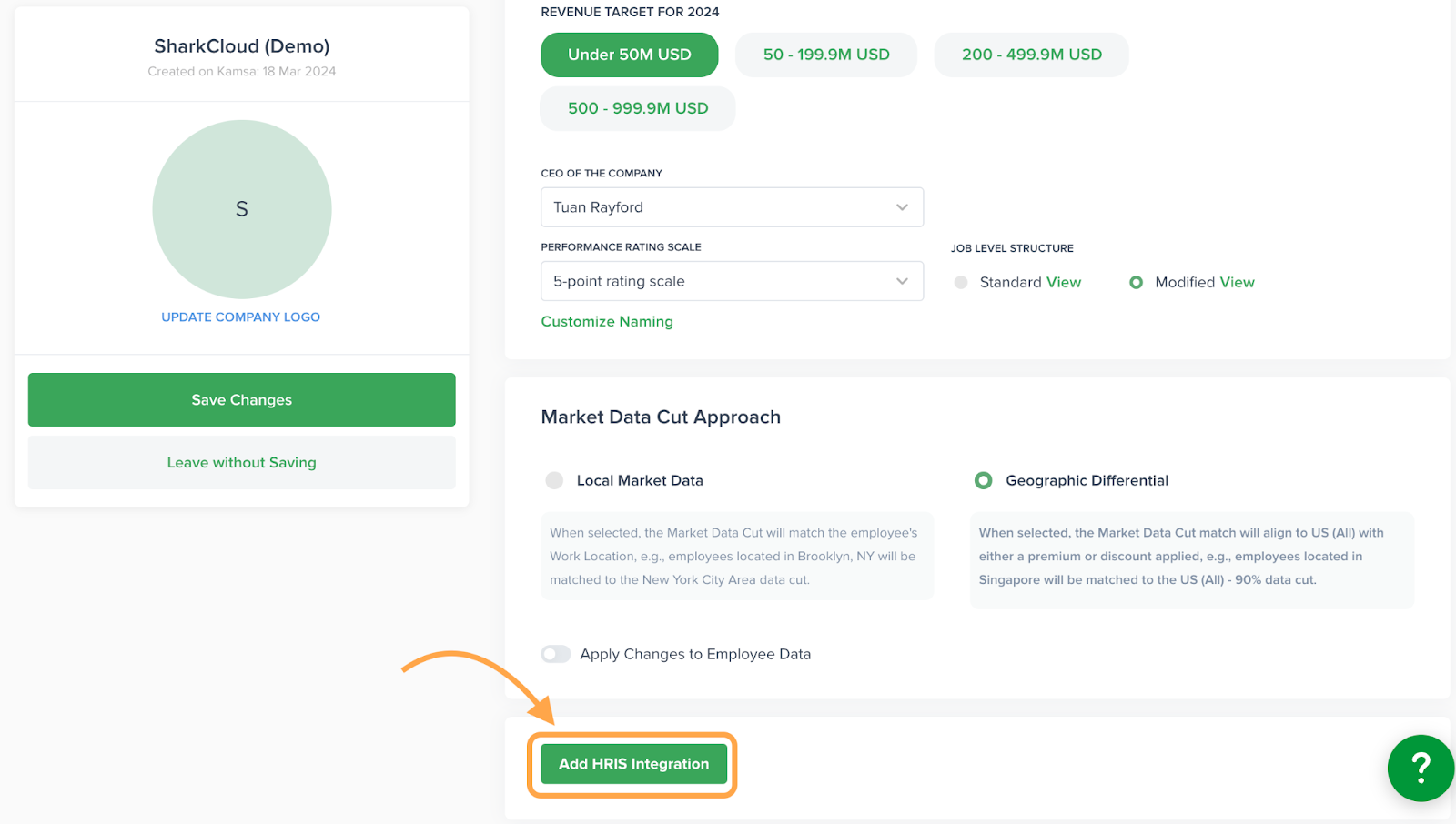
-
For the HRIS Name, select Bob - Direct.
For the API field, add your Bob Service ID:Token and then select Save & Close.
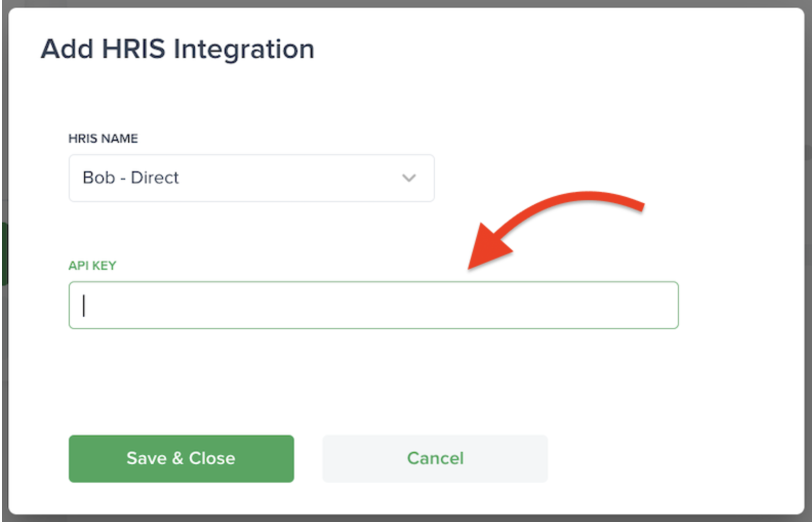
-
Select Save Changes to the Company Profile page.
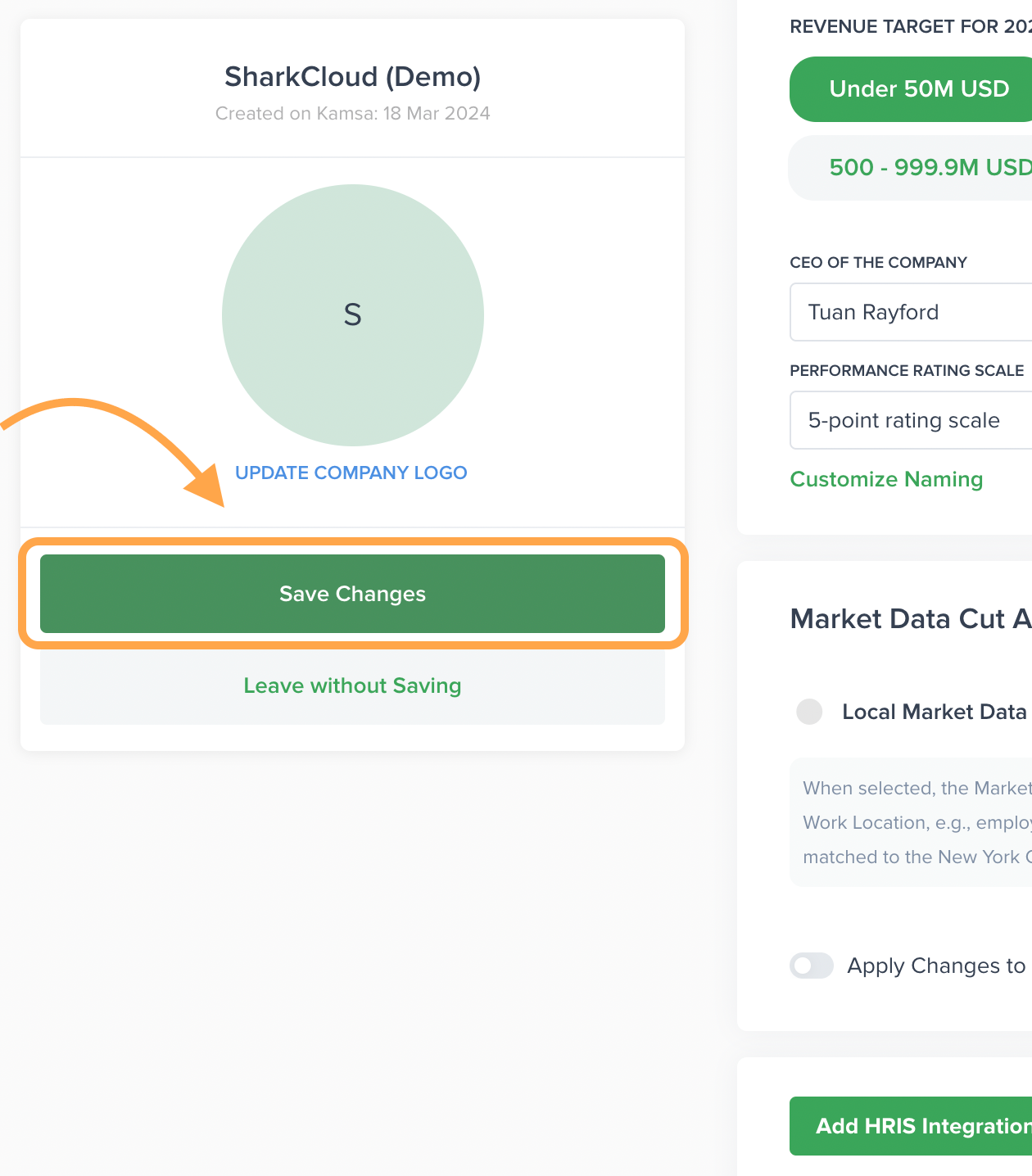
Step 3: Email [email protected] to test and finalize your import
Once you have completed the above steps, email [email protected] to let us know you’ve completed the above steps.
Summary
Once you have completed the above steps, Kamsa will create a duplicate workspace to test the import of the data.
As soon as we’ve confirmed that the data is imported without errors, Kamsa will enable the Import from HRIS option so it displays within the Upload Employees button drop-down within your Employee Data page.

Field Mapping from HiBob into Kamsa
To create a customized report with all these fields, see the Kamsa HRIS Integrations Guide — HiBob (Report-based Customization)
| Category | Field Name in HiBob | Notes |
|---|---|---|
| Basic Info | Full name | In Kamsa, first and last name are used together for the Employee Name field. |
| Work | Employee ID | Kamsa accepts numeric and alphanumeric characters. Each Employee ID must be a unique identifier. |
| Work | Department | In Kamsa, there are different types of Departments which allows users to retain their Company’s nomenclature while benchmarking to Kamsa’s market data. |
| Work | Job Title | In Kamsa, there are different types of Job Titles which allows users to retain their Company’s nomenclature while benchmarking to Kamsa’s market data. |
| Work | Manager’s ID | Kamsa uses this information primarily to map Managers in Kamsa. This field is required and must exactly match the employee ID of the manager. |
| Work | Start date | There are other options here such as “Work effective date” but Kamsa uses “Start date.” |
| Address | State/Province/Region | Depending on what fields are available. “city, state/region”, “city, country”, “state/region, country”, “country” |
| Address | Country | This is the primary field that Kamsa uses to determine the Market Data Cut for each employee. Here we want the country of the individual represented, not the “Site country” option, for example, because it is important to calibrate the employee’s pay and compa-ratio according to where they live and not where their employee office may be, as these don’t always align. |
| Address | City | While Bob offers various ways to determine an employee’s location, we use the Employee’s Work Location secondarily for clarification of which Market Data Cut we should use. Kamsa will not recognize Site country, Site or Site City. Depending on what fields are available. “city, state/region”, “city, country”, “state/region, country”, “country” |
| Payroll | Base salary | Kamsa accepts Base Salary in the form of an annual or hourly amount. |
| Payroll | Base salary currency code | You’ll see several options here such as “Base Salary (USD)” but we specifically will need the “Base salary currency code.” |
| Payroll | Salary pay period | At this time, Kamsa converts all pay basis directly to salary or hourly. Kamsa will receive yearly, every 6 months, quarterly, monthly, every 2 weeks, per day, per hour, or weekly pay frequencies but convert it to yearly. |
| Payroll | Last salary change date | |
| Payroll | Commission amount | Kamsa will multiply this amount by the employee’s Commission Pay Period |
| Payroll | Commission amount currency | |
| Payroll | Commission pay period | This is used to calculate a yearly target commission amount |
| Payroll | Annual bonus % | Kamsa will accept a % and calculate a yearly bonus amount |
| Employment | Employment type | Kamsa accepts Full-Time, Part-Time, Temporary and Contractor. Kamsa will map the distinct Bob attributes as follows: - Intern, Freelance and Temporary will be imported as Temporary in Kamsa. - Contract and Contractor will be imported as Contractor in Kamsa. - Permanent will be imported as Full-Time |
| Employment | Weekly hours | This is only required if you have PT employees. |
| Employment | FLSA code | Exempt or non exempt |
| Lifecycle | Status | In Kamsa, we have Active, Terminated and Leave of absence. Kamsa will map the Bob attributes as follows: - Hired and Employed will be imported as Active in Kamsa. - Terminated will not be imported in Kamsa. - Garden Leave, Leave, Parental Leave will be imported as Leave of absence in Kamsa. Note: Employees that are previously Active in Kamsa, but then marked as terminated will be updated to Terminated in Kamsa. Historically terminated employees will not be added to Kamsa. |
| Home | Gender | Kamsa accepts Male, Female, and Non-binary as values. |
Note: Kamsa currently imports Employees with 0 salary (you will have to delete those from Kamsa after import if you do not wish them to be in Kamsa).
Kamsa HRIS Integrations Guide — HiBob (v2024-07-24)